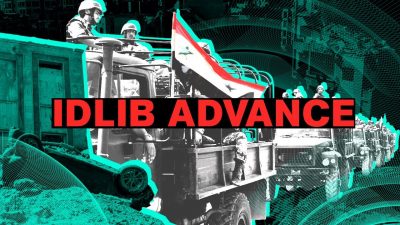Video: Syrian Army Developing Advance in Southern Idlib

Tensions are heating up around the militant-held parts of Idlib and Aleppo provinces.
On November 22, the Syrian Army conducted a wide-scale missile strike on militants’ positions in western Aleppo. According to pro-militant sources, at least 15 improvised rocket-assisted munitions were employed. 2 large weapon depots belonging to radicals were targeted. The strike came in response to the November 21 incident, when militant shelling killed or injured at least 37 people in the city of Aleppo.
On November 23, the army eliminated several militants with anti-tank guided missiles and artillery strikes around Rakaya Sijneh and the al-Nar hilltop. On the same day, a Russian airstrike destroyed a headquarters of Jayish al-Izaa, mostly known for its ties with al-Qaeda, near Kafr Nabl.
On November 24, the army resumed its ground operation against Hayat Tahrir al-Sham and other radical groups in southern Idlib. Backed up by air and artillery strikes, army troops liberated the town of Misherfah and secured several positions around it. Militants carried out two counter-attacks to recapture Misherfah, but they were repelled. According to pro-government sources, up to 9 militants were eliminated.
Earlier in November, government forces liberated Luwaybidah and the Khaznah Hill in the same area. It’s expected that the army and its allies will continue their counter-terrorism efforts and further steadily cleaning southern Idlib.
On November 23, a coalition of Turkish-backed militant groups, known as the Syrian National army, launched a wide-scale attack on positions of the Kurdish-led Syrian Democratic Forces (SDF) and the Syrian Army near Ayn Issa in northern Raqqa. By November 24, they had captured the villages of Saida, Mu’laq and al-Wasta, and reached the vicinity of Ayn Issa itself.
Then, united forces of the SDF and the Syrian Army pushed Turkish-backed militants back recapturing Saida, Mu’laq and al-Wasta, and once again securing the area. Despite this, artillery duels along the contact line north of Ayn Issa continued.
Over the past weeks, the Turkish Army established several fortified positions near the M4 highway in northern Raqqa and eastern al-Hasakah. Taking into account that Turkish proxies cannot carry out any large-scale offensive actions without Ankara’s approval, the Turkish leadership is likely aiming to use the instability in northeastern Syria to occupy more area. The M4 highway, which is the main transportation line in this part of the country, is an apparent target.
Central Command chief General Kenneth McKenzie revealed on November 23 that around 500 US troops remain deployed on the eastern bank of the Euphrates and in al-Hasakah. These troops will soon resume their anti-terrorist activities, General McKenzie added.
The US withdrawal from northern Syria allowed it to avoid the involvement in the ongoing standoff over the so-called Kurdish question. Washington used the gained time to fortify its positions in oil-rich areas of eastern Syria.
*
Note to readers: please click the share buttons above or below. Forward this article to your email lists. Crosspost on your blog site, internet forums. etc.
We call upon Global Research readers to support South Front in its endeavors.
If you’re able, and if you like our content and approach, please support the project. Our work wouldn’t be possible without your help: PayPal: [email protected] or via: http://southfront.org/donate/ or via: https://www.patreon.com/southfront

